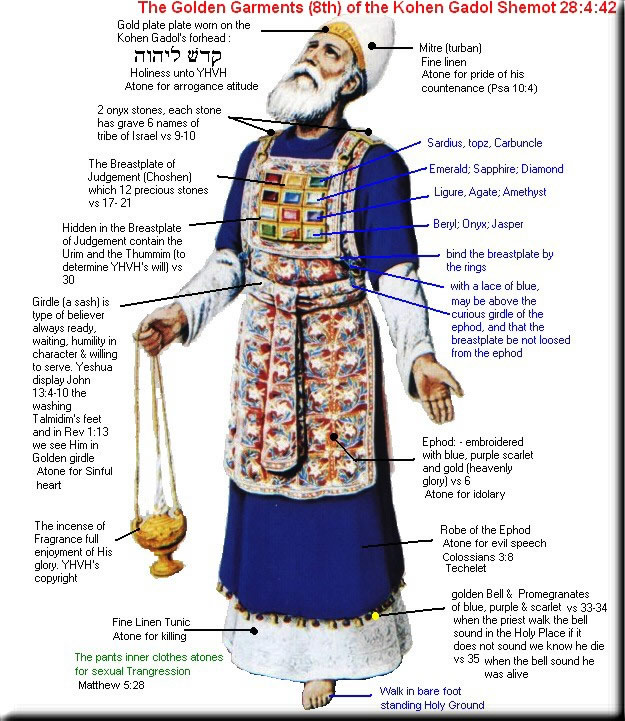Day 52, Chronological Bible Study Timeline. Map. Go to today’s Bible reading (use your browser arrow to return): Leviticus 16
It's Time for a Cleanup
Many people do spring and fall cleaning. They clean their yards and garages and begin or finish outside projects. They also have their windows cleaned, carpets shampooed, and remove any disorder or accumulations in or outside their homes. Many will do everything before the hot summer days or before the holidays.
Spiritually speaking, this was the reason for the Day of Atonement instituted in Israel—a cleanup of their souls before the holiday of their Thanksgiving festival. Is it time for a spiritual cleanup in our lives?
In today's Bible reading, the Israelites bring offerings for dedication, unintentional sin, guilt, and thanksgiving. However, there is a problem early on—things weren't done right! Nadab and Abihu, sons of Aaron, the high priest, were taking censers (firepans) with incense to offer “unauthorized fire” (Leviticus 10:1). This may mean they filled their censers with coals from the altar and entered behind the curtain of the Most Holy Place. Only the high priest (their father, Aaron) could enter on the Day of Atonement (Leviticus 16:11-12). It's also possible these sons of Aaron were drunk and disorderly (Leviticus 10:8-9). For this, God exercised capital punishment.Immediately after this incident, God tells Aaron he must distinguish between the clean and unclean, i.e., what is ceremonially holy from what is unholy because the LORD is holy (Leviticus 10:10).
He further instructs him, “You must keep the Israelites separate from things that make them unclean, so they will not die in their uncleanness for defiling my dwelling place, which is among them” (Leviticus 15:31, NIV).
A Spiritual Cleanup Day
For whatever reason, some sins weren't dealt with during the year, and many Israelites weren't spiritually clean. We've read about the sacrifices for unintentional sins. The Day of Atonement is for all kinds of inappropriate behavior, for intentional and unintentional wrongdoing. God instituted a Day of Atonement, a day of spiritual cleanup in the fall (in the month of Tishri late October, or early November). Some churches have spring and fall revivals for a similar purpose.
The Day of Atonement; it's Purpose and Procedures
God set aside this day of atonement to purify the priests, the rest of the Israelites, and to cleanup and purify the tent of worship (the tabernacle).
For this ceremony, the high priest doesn't wear his usual vestments. After bathing in the bronze basin, he wears only his linen tunic, undergarments, sash, and a linen turban—it's a day of humility. It's preceded by fasting and a Sabbath day's rest.
1. On the Day of Atonement, the high priest must do the sin sacrifice alone. After sacrificing the bull for his own sins, he makes three entrances behind the Holy of Holies (the Most Holy Place, separated by a thick ornate curtain).
Aaron takes coals in a censer, adds a handful of incense to the firepan to create smoke. The smoke goes before him as he enters the Holy of Holies, and it hides the mercy seat (the golden lid with angels on top of the Ark of the Covenant). This is so the high priest can't look at the glory of God, which is present.
Then the high priest goes back to the altar to bring some of the bull's blood with him behind the curtain. Aaron, the high priest, sprinkles blood on and before the mercy seat seven times to symbolize purification from the sins offered there. He is doing this to atone for himself and his household.
2. The Sin Offering for the Israelites
Next, the high priest repeats the procedure with the goat's blood for the sins of the Israelites.
3. The Purification of the Tabernacle
As a symbolic way to purify the tabernacle from the sin offerings, the high priest comes out from the Holy of Holies and sprinkles blood seven times on the Holy Place of the Tabernacle and then on the bronze altar. Last, the high priest takes the blood and smears some on the horns of the bronze and pours the rest of it at its base.
The Symbolism of the Scapegoat
After the sacrifices and atonement, God leaves these instructions:
When Aaron has finished making atonement for the Most Holy Place, the Tent of Meeting and the altar, he shall bring forward the live goat. He is to lay both hands on the head of the live goat and confess over it all the wickedness and rebellion of the Israelites—all their sins—and put them on the goat’s head. He shall send the goat away into the desert in the care of a man appointed for the task. The goat will carry on itself all their sins to a solitary place; and the man shall release it in the desert. (Leviticus 16:20-22, NIV).
The scapegoat ceremony symbolically portrays what Jesus does for us—he carries our sins away, as far as the east is from the west (Psalm 103:12)
Jesus, our High Priest
Jesus is the high priest who goes behind the veil of the Holy of Holies. He doesn't offer a bull's blood to sacrifice for his own sins because he is perfect, but he provides something better for us. He doesn't sprinkle the blood of bulls and goats on and before the mercy seat because they only ceremonially cover sin. Jesus goes into the Holy of Holies in heaven, having offered his own blood on the altar, the cross of Calvary. He makes atonement for us and does away with all our sins, both intentional and unintentional. “God presented him [Christ] as a sacrifice of atonement [a payment to make amends for our sins], through faith in his blood” (Romans 3:25, NIV). His forgiveness is available to all who trust in Christ’s blood to cleanse them from their sins! (Hebrews 9:7-14, 24-26; 1John 1:7).
Christians, have we been lax in coming to God for regular cleaning of our spiritual lives? If so, it's time for a cleanup! It's time to get rid of the dirt and clutter of sin we have accumulated. Let's turn away from our sins and come to God in humility, genuine sorrow, and confession for a thorough cleansing of our sins. Jesus Christ offers complete cleaning and forgiveness (1John 1:9). If we call upon God to clean us up, we can be really clean and ready to celebrate with thanksgiving!
End Note: The Bible Knowledge Commentary of the O.T. by Walvoord and Zuck, ©1985, p.198.
Discussion
What was the preparation for the spiritual cleanup known as the Day of Atonement? Why is this important?
How can we have complete forgiveness of our sins? Do we need animal sacrifices? Why or why not?
Endnote: The Bible Knowledge Commentary of the O.T. by Walvoord and Zuck, ©1985, p.198)
Focus Verse
1Corinthians 6:11 (NIV) “And that is what some of you were. But you were washed, you were sanctified, you were justified in the name of the Lord Jesus Christ and by the Spirit of our God.” (NIV)
Write a private prayer response to today’s Bible study:
Please send your comments to me, Rod, the author
Looking Ahead: Now that we have had a spiritual cleanup, how do we stay clean? Our next lesson will help us: Staying Clean; a Practical Guide to Holiness. Join us!
Back to top of page
Return to Chronological Bible Studies main page
Go to Scriptures main page
Go to Topics main page
re-edited 2-21-23
COPYRIGHT @ 2019, MASTER'S TOUCH BIBLE STUDIES



